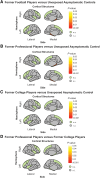Brain morphometry in former American football players: findings from the DIAGNOSE CTE research project
- PMID: 38533783
- PMCID: PMC11449133
- DOI: 10.1093/brain/awae098
Brain morphometry in former American football players: findings from the DIAGNOSE CTE research project
Abstract
Exposure to repetitive head impacts in contact sports is associated with neurodegenerative disorders including chronic traumatic encephalopathy (CTE), which currently can be diagnosed only at post-mortem. American football players are at higher risk of developing CTE given their exposure to repetitive head impacts. One promising approach for diagnosing CTE in vivo is to explore known neuropathological abnormalities at post-mortem in living individuals using structural MRI. MRI brain morphometry was evaluated in 170 male former American football players ages 45-74 years (n = 114 professional; n = 56 college) and 54 same-age unexposed asymptomatic male controls (n = 54, age range 45-74). Cortical thickness and volume of regions of interest were selected based on established CTE pathology findings and were assessed using FreeSurfer. Group differences and interactions with age and exposure factors were evaluated using a generalized least squares model. A separate logistic regression and independent multinomial model were performed to predict each traumatic encephalopathy syndrome (TES) diagnosis, core clinical features and provisional level of certainty for CTE pathology using brain regions of interest. Former college and professional American football players (combined) showed significant cortical thickness and/or volume reductions compared to unexposed asymptomatic controls in the hippocampus, amygdala, entorhinal cortex, parahippocampal gyrus, insula, temporal pole and superior frontal gyrus. Post hoc analyses identified group-level differences between former professional players and unexposed asymptomatic controls in the hippocampus, amygdala, entorhinal cortex, parahippocampal gyrus, insula and superior frontal gyrus. Former college players showed significant volume reductions in the hippocampus, amygdala and superior frontal gyrus compared to the unexposed asymptomatic controls. We did not observe Age × Group interactions for brain morphometric measures. Interactions between morphometry and exposure measures were limited to a single significant positive association between the age of first exposure to organized tackle football and right insular volume. We found no significant relationship between brain morphometric measures and the TES diagnosis core clinical features and provisional level of certainty for CTE pathology outcomes. These findings suggested that MRI morphometrics detect abnormalities in individuals with a history of repetitive head impact exposure that resemble the anatomic distribution of pathological findings from post-mortem CTE studies. The lack of findings associating MRI measures with exposure metrics (except for one significant relationship) or TES diagnosis and core clinical features suggested that brain morphometry must be complemented by other types of measures to characterize individuals with repetitive head impacts.
Keywords: former American football players; neuroimaging; repetitive head impact; sports-related head injury; structural MRI.
© The Author(s) 2024. Published by Oxford University Press on behalf of the Guarantors of Brain.
Conflict of interest statement
L.B. is the Editor-in-Chief of the
Figures



References
MeSH terms
Grants and funding
- Grass Foundations Henry Grass M.D. Rising Star in Neuroscience Award
- Black Men's Brain Health Emerging Scholars Fellowship
- P20 AG068053/AG/NIA NIH HHS/United States
- Harvard's Mind Brain and Behaviour Young Investigator Award
- P30 AG072980/AG/NIA NIH HHS/United States
- K00 NS113419/NS/NINDS NIH HHS/United States
- R01 NS139383/NS/NINDS NIH HHS/United States
- L32 MD016519/MD/NIMHD NIH HHS/United States
- Rainwater Charitable Foundation Tau Leadership Fellows Award
- U01NS093334/NS/NINDS NIH HHS/United States
- U01 NS093334/NS/NINDS NIH HHS/United States
- NIH
- Burroughs Wellcome Fund Postdoctoral Diversity Enrichment Program
- P20 GM109025/GM/NIGMS NIH HHS/United States
LinkOut - more resources
Full Text Sources
Medical

